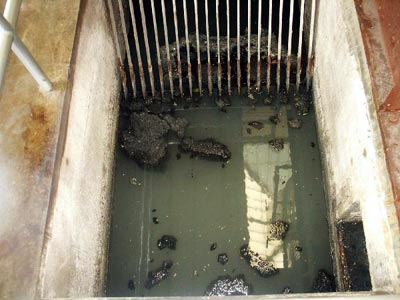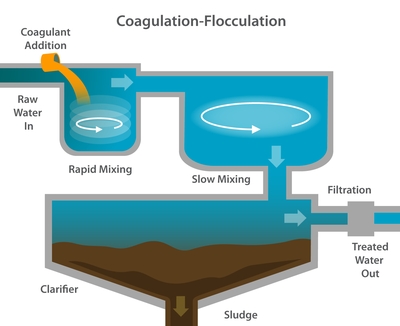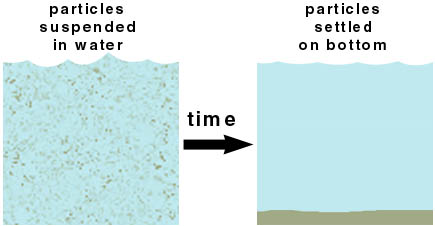Discussion Board | Supplemental Reading![]() Welcome to Water & Wastewater Treatment! This will be an informative, yet fun course that will provide you with a basic understanding of water quality and waste treatment. The objective of Module 3 is to introduce the physical separation treatment stages, including:
Welcome to Water & Wastewater Treatment! This will be an informative, yet fun course that will provide you with a basic understanding of water quality and waste treatment. The objective of Module 3 is to introduce the physical separation treatment stages, including:
- Flow, Screens, Reactors
- Mixing and Flocculation
- Sedimentation
- Filtration
PHYSICAL SEPARATION TECHNIQUES
Physical methods include processes where no gross chemical or biological changes are carried out and strictly physical phenomena are used to improve or treat the wastewater.
Examples would be coarse screening to remove larger entrained objects and sedimentation (or clarification). In the process of sedimentation, physical phenomena relating to the settling of solids by gravity are allowed to operate. Usually this consists of simply holding a wastewater for a short period of time in a tank under quiescent conditions, allowing the heavier solids to settle, and removing the “clarified” effluent. Sedimentation for solids separation is a very common process operation and is routinely employed at the beginning and end of wastewater treatment operations. While sedimentation is one of the most common physical treatment processes that is used to achieve treatment, another physical treatment process consists of aeration — that is, physically adding air, usually to provide oxygen to the wastewater. Still other physical phenomena used in treatment consists of filtration. Here wastewater is passed through a filter medium to separate solids. An example would be the use of sand filters to further remove entrained solids from a treated wastewater. Certain phenomena will occur during the sedimentation process and can be advantageously used to further improve water quality. Permitting greases or oils, for example, to float to the surface and skimming or physically removing them from the wastewaters is often carried out as part of the overall treatment process. In certain industrial wastewater treatment processes strong or undesirable wastes are sometimes produced over short periods of time. Since such “slugs” or periodic inputs of such wastes would damage a biological treatment process, these wastes are sometimes held, mixed with other wastewaters, and gradually released, thus eliminating “shocks” to the treatment plant. This is call equalization. Another type of “equalization” can be used to even out wide variations in flow rates. For example, the wet well of a pump station can receive widely varying amounts of wastewater and, in turn, pump the wastes onward at more uniform rates.
Screening
Screening is the first treatment station, both for surface and wastewater. It’s purpose to:
- Protect the structure downstream against large objects which could create obstructions in some of the facility’s units,
- Easily separate and remove large matter carried along by the raw water, which might negatively affect the efficiency of later treatment procedures or make their implementation more difficult.
Figure 1: Coarse screening for large particles
The efficiency of the screening operation depends of the spacing between screen bars:
- Fine screening, for a spacing under 10 mm
- Medium screening, for spacing of 10 to 40 mm
- Coarse screening, for spacing of over 40 mm
Usually the fine screening is preceded by a preliminary screening operation for purposes of protection. Screening is carried to out by a manually cleaned bar screen (large in size, in order to reduce the frequency of screenings collection operations) or, preferably, by an automatically cleaned bar screen (essential in cases of high flow rates of for water with a high solids content). The automatic bar screen is usually protected by a sturdy preliminary bar screen, which should also be provided with an automatic cleaning systems in large facilities and in case of raw water containing a high volume of coarse matter. To reduce manual operations as much as possible, screening procedures have become increasingly automated, even in small facilities. Automation is essential in situations where large amounts of plant matter are carried by the water and arrive all at once at the bar screen, tending to mat the bars and completely clogging the screen in a few minutes. Fine screens must be automated. The collected refuse is stored in a container of given capacity, calculated according the acceptable frequency of refuse disposal operations. Usual spacing are:
- For surface waters, between 20 and 40 mm (upstream the strainer)
- For municipal wastewater: for raw water, from 15 to 30 mm (but upstream from a straining and/ or lamellae settling process, fine screening is necessary); for sludge (if necessary), 10 mm or less
- For some industrial effluents, especially agri-food effluents, fine bar screening ( or at times, medium screening followed by straining)
Flocculation
Flocculation, is the action of polymers to form bridges between the flocs (particles) and bind the particles into large agglomerates or clumps. Bridging occurs when segments of the polymer chain adsorb on different particles and help particles aggregate. An anionic flocculant will react against a positively charged suspension, adsorbing on the particles and causing destabilization either by bridging or charge neutralization. In this process it is essential that the flocculating agent be added by slow and gentle mixing to allow for contact between the small flocs and to agglomerate them into larger particles. The newly formed agglomerated particles are quite fragile and can be broken apart by shear forces during mixing. Care must also be taken to not overdose the polymer as doing so will cause settling/clarification problems. Anionic polymers themselves are lighter than water. As a result, increasing the dosage will increase the tendency of the floc to float and not settle.
Figure 2: Coaguluation-Flocculation
Once suspended particles are flocculated into larger particles, they can usually be removed from the liquid by sedimentation, provided that a sufficient density difference exists between the suspended matter and the liquid. Such particles can also be removed or separated by media filtration, straining or floatation. When a filtering process is used, the addition of a flocculant may not be required since the particles formed by the coagulation reaction may be of sufficient size to allow removal. The flocculation reaction not only increases the size of the floc particles to settle them faster, but also affects the physical nature of the floc, making these particles less gelatinous and thereby easier to dewater.
Sedimentation
Sedimentation (settling) is the separation of suspended particles that are heavier than water. The sedimentation of particles are based on the gravity force from the differences in density between particles and the fluid. Sedimentation is widely used in wastewater treatment systems. A successful sedimentation is crucial for the overall efficiency of the plant. Common examples include the removal of:
- Grit and particulate matter in the primary settling basin (settling tanks that receive raw wastewater prior to biological treatment are called primary tanks)
- Sludge from the bioreactor (activated sludge process).
- Chemical flocs in the chemical step.
Figure 3: Sedimentation
Often, the settler connected to the activated sludge process is the main bottle neck in the plant. The seemingly simple process has proven to be the weak link in many wastewater treatment plants. The implementation of nitrogen removal in many water and wastewater treatment plants emphasis the importance of the settler. The slow growth of nitrifying bacteria means that a high sludge age is necessary in the activated sludge process. For a give volume of the aeration basin, the sludge age may be increased by using a higher sludge concentration in the basin. However, by increasing the sludge concentration in the aeration basin, the capacity of the settler may be reached, the sludge blanket level will then increase which finally results in an uncontrolled sludge escape in the effluent water. Hence, there is a possible conflict between operation for good nutrient removal (high sludge age) and operation for good sludge sedimentation. Further, nitrogen removal in the activated sludge process gives also a risk for sludge rise in the secondary settler due to denitrification in the bottom of the settler. The sludge may rise due to flotation of solids when nitrogen gas is released. Note also that the settler has two functions; clarification and sludge separation. That is to remove essentially all of the solids from suspension and to concentrate theses solids (eg for recycling to the aeration basin). Depending on the particles concentration and the interaction between particles, four types of settling can occur:
- Discrete particle settling. The particles settle without interaction and occurs under low solids concentration. A typical occurrence of this type of settling is the removal of sand particles.
- Flocculent settling. This is defined as a condition where particles initially settle independently, but flocculate in the depth of the clarication unit. The velocity of settling particles are usually increasing as the particles aggregates. Th mechanisms of flocculent settling are not well understood.
- Hindered settling. Inter-particle forces are sufficient to hinder the settling of neighboring particles. The particles tend to remain in a fixed positions with respect to each others. This type of settling is typical in the settler for the activated sludge process (secondary clarifier).
- Compression settling. This occurs when the particle concentration is so high that so that particles at one level are mechanically influenced by particles on lower levels. The settling velocity then drastically reduces.
Filtration
Wastewater contaminants can be separated from water by the use of physical separation technologies including membrane and particulate filtration methods. Particulate filtration is employed for the removal of solids greater than 10 microns in diameter. Particulate filtration is primarily used for the removal of organic and inorganic solids, chemical precipitates (including heavy metal residuals) and biomass and other residuals from secondary treatment. Membrane technologies, on the other hand, are used for the removal of materials that are generally smaller than one micron in diameter. Particulate filtration is often used as a pretreatment step for membrane separation technologies. Filtration in wastewater treatment is often employed as a tertiary treatment step for the removal of suspended solids. The filtration unit may be located at the end of a biological treatment train and use clarifier or settling lagoon effluent as its feed. Wastewater filters may also be used as part of a physical/chemical process and serve as a polishing step to improve suspended solids/heavy metals removal. Many types of filters are available on the market, but in the environmental field, granular media filters are most extensively used for wastewater treatment. Granular media filters use sand or a combination of sand and other granular media (garnet, anthracite, etc.). Granular media filters may be operated with gravity feed, or the influent may be pumped in under pressure either in the up-flow or down-flow mode.
Figure 4: Granular media filter (sand filter)
SUPPLEMENTAL READING
Treatment of oily wastewater produced from post-treatment unit of refinery processes using flocculation and microfiltration with zirconia membrane was studied in this paper.
Coagulation–flocculation and flotation processes were evaluated for the pre-treatment of hospital wastewater, including the removal of 13 pharmaceutical and personal care products (PPCPs).







